Administrative
Information
|
|
Ancient Olympia, Τ.Κ. 27 065, Olympia (Prefecture of Ilia)
Telephone: +30 26240 22742
Tickets
Full: €6, Reduced: €3
Special ticket package: Full: €9, Reduced: €5
Valid for: Archaeological Museum of Olympia, Olympia
Free admission days
Special ticket package: Full: €9, Reduced: €5
Valid for: Archaeological Museum of Olympia, Olympia
Free admission days
Sundays in the period between 1 November and 31 March
The first Sunday of every month, except for July, August and September (when the first Sunday is holiday, then the second is the free admission day.)
27 September, International Tourism Day
Reduced admission for:
The first Sunday of every month, except for July, August and September (when the first Sunday is holiday, then the second is the free admission day.)
27 September, International Tourism Day
Reduced admission for:
Citizens of the E.U. aged over 65
Students from countries outside the E.U.
Free admission for:
Students from countries outside the E.U.
Free admission for:
Journalists
Members of the ICOM-ICOMOS
Persons possessing a free admission card
Persons under 19
Soldiers carrying out their military service
Tour guides
University students from Greece and the E.U.
Members of the ICOM-ICOMOS
Persons possessing a free admission card
Persons under 19
Soldiers carrying out their military service
Tour guides
University students from Greece and the E.U.
Open
Winter: From the 1st of November until the 31 of March: 8:30-15:00
On Mondays: 10:30 - 17:00
(Last Updated: 2 Dec 2011)
Holidays
1 January
25 March
Good Friday: 12.00 - 17.00
1 May
Easter Sunday
25 December
Winter: From the 1st of November until the 31 of March: 8:30-15:00
On Mondays: 10:30 - 17:00
(Last Updated: 2 Dec 2011)
Holidays
1 January
25 March
Good Friday: 12.00 - 17.00
1 May
Easter Sunday
25 December
26 December
more information and photo
http://www.olympia-greece.org/museum.html
http://hellenicperiod.blogspot.com/2010/08/ancient-olympia-museum.html
 Greece, Peloponnesos, Elis, Olympia Museum, Lapith women
Greece, Peloponnesos, Elis, Olympia Museum, Lapith women
From the west end of the Temple of Zeus, pedimental sculpture, 5th century BC. depicting the fight between the Lapiths and the Centaurs. Here, two Lapith women look on, originally confined by the corner of the pediment.
http://hellenicperiod.blogspot.com/2010/08/ancient-olympia-museum.html

From the west end of the Temple of Zeus, pedimental sculpture, 5th century BC. depicting the fight between the Lapiths and the Centaurs. Here, two Lapith women look on, originally confined by the corner of the pediment.
Greece, Peloponnesos, Elis, Olympia Museum, Nike of Paionios
Even a fragmentary faceless reconstructed statue has a beauty. This is the statue of Victory (Nike) the work of Paionios of Mende in the Greek Chalkidike peninsula, c. 420 BC. The inscription on the pedestal also mentions that it was a votive offering made by the Messenians and the Naupaktians (from Naupaktos, also known as Lepanto).
Even a fragmentary faceless reconstructed statue has a beauty. This is the statue of Victory (Nike) the work of Paionios of Mende in the Greek Chalkidike peninsula, c. 420 BC. The inscription on the pedestal also mentions that it was a votive offering made by the Messenians and the Naupaktians (from Naupaktos, also known as Lepanto).
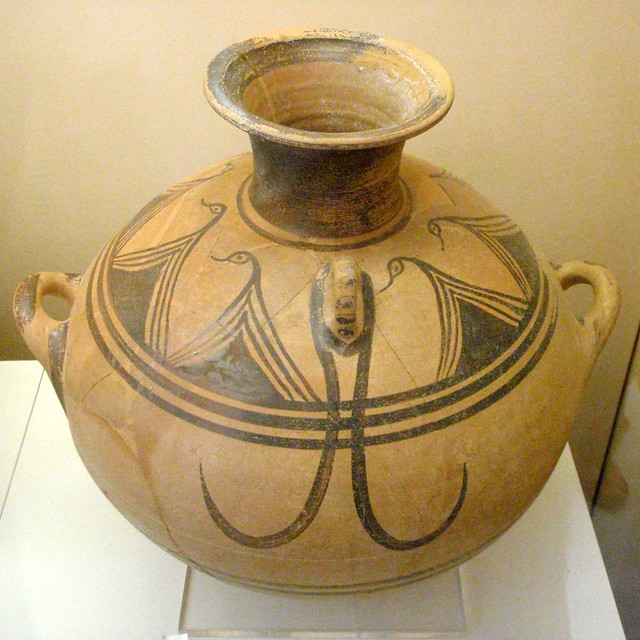
Four-handled amphora
Trypes (Olympia), Chamber Tomb A
LH IIIC Late
Olympia, Archaeological Museum inv. Π 561
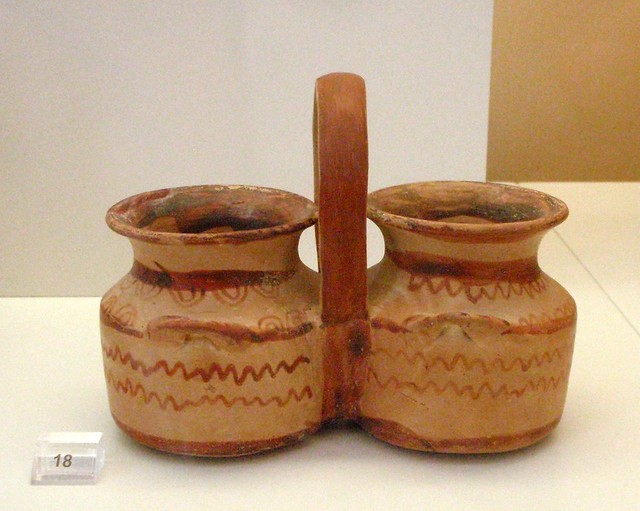
Kernos
Trypes, Olympia, Chamber Tomb E
LH IIIC Middle
Olympia, Archaeological Museum inv. Π 631
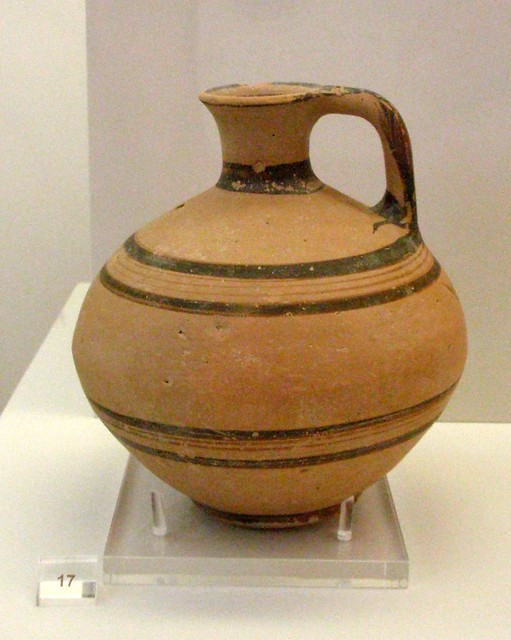
LH IIIC Jug from Olympia Jug
Olympia, Kladeos (chance find)
LH IIIC
Olympia, Archaeological Museum inv. Π 309

Four-handled amphoriskos
Trypes, Olympia, Chamber Tomb Δ
LH IIIC
Olympia, Archaeological Museum inv. Π 597

Tripod pyxis
Trypes, Olympia, Chamber tomb Δ
LH IIIC Late
Olympia, Archaeological Museum inv. Π 592
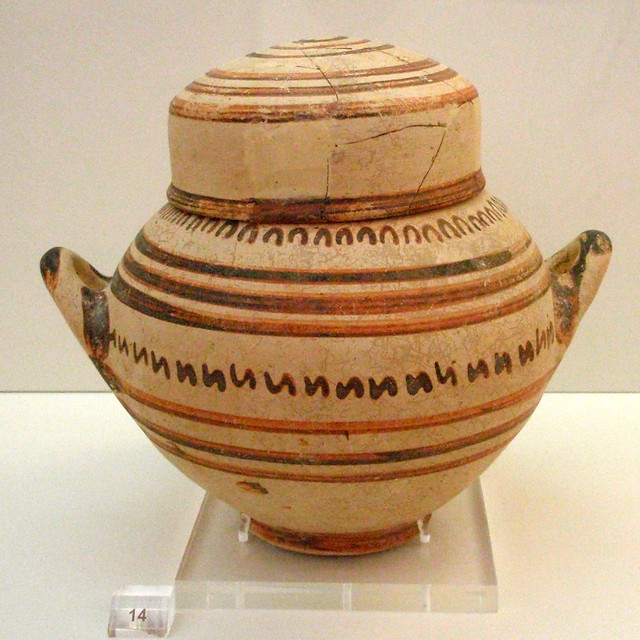
Lidded pitcher
Trypes, Olympia, destroyed chamber tomb
LH IIIC
Olympia, Archaeological Museum inv. Π 354

Stirrup jar
Trypes, Olympia, Chamber tomb A
LH IIIC
Olympia, Archaeological Museum inv. Π 563
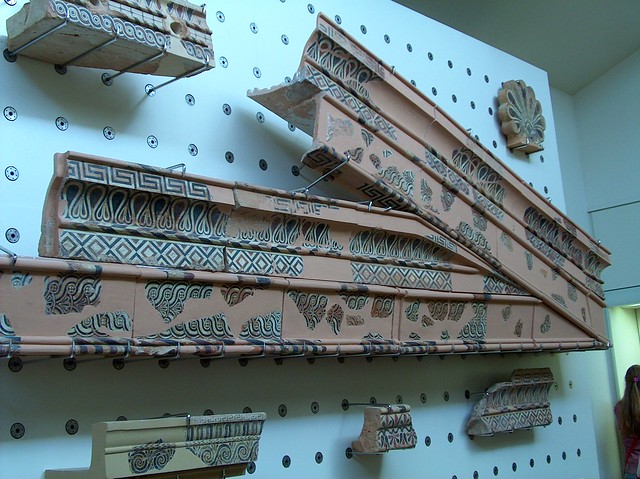

340-330 a.C
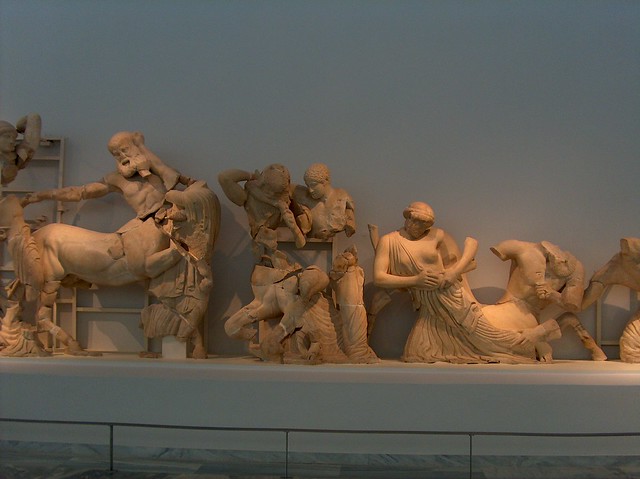



Ornaments Temple of Zeus

Olimpia: Museo Archeologico

olympia museum/western pediment
The sculptured ornaments from the Temple of Zeus.
There were 42 figures decorating the 2 pediments of the temple, 12 metopes and the lion-headed water spouts running along the lengths of the temple. It is one of the best surviving ensembles from ancient Greek works of art. They belong to the "austere style" and date to the 1st half of the 5th century B.C.
The eastern pediment depicts the chariot race between Pelops and Oinomaos, and the central figure which dominates the work is of Zeus. The western pediment depicts the abduction of the Lapith women by Centaurs, and has Apollo as its central figure. The metopes bear the relief representation of Hercules' labours. These sculptures were made during the 5th century B.C.
As you can see there are in much better shape thtan the ones from the Parthenon in Acropolis.
The sculptured ornaments from the Temple of Zeus.
There were 42 figures decorating the 2 pediments of the temple, 12 metopes and the lion-headed water spouts running along the lengths of the temple. It is one of the best surviving ensembles from ancient Greek works of art. They belong to the "austere style" and date to the 1st half of the 5th century B.C.
The eastern pediment depicts the chariot race between Pelops and Oinomaos, and the central figure which dominates the work is of Zeus. The western pediment depicts the abduction of the Lapith women by Centaurs, and has Apollo as its central figure. The metopes bear the relief representation of Hercules' labours. These sculptures were made during the 5th century B.C.
As you can see there are in much better shape thtan the ones from the Parthenon in Acropolis.
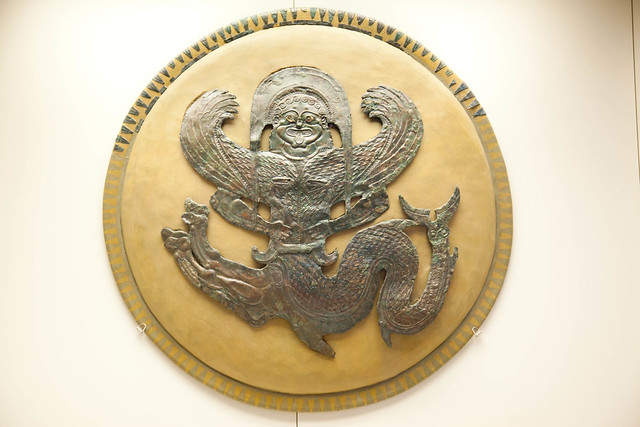
Shield
The Archaeological Museum of Olympia, one of the most important museums
in Greece, presents the long history of the most celebrated sanctuary of
antiquity, the sanctuary of Zeus, father of both gods and men, where
the Olympic games were born. The museum's permanent exhibition contains
finds from the excavations in the sacred precinct of the Altis dating
from prehistoric times to the Early Christian period. Among the many
precious exhibits the sculpture collection, for which the museum is most
famous, the bronze collection, the richest collection of its type in
the world, and the large terracottas collection, are especially
noteworthy.
The museum building comprises exhibition rooms, auxiliary spaces and
storerooms. The vestibule and twelve exhibition rooms contain objects
excavated in the Altis. The auxiliary spaces (lavatories) are located in
the museum's east wing; a separate building between the museum and the
archaeological site houses a book and souvenir shop. Finally, part of
the east wing and the basement are dedicated to storage and conservation
of terracottas, bronze, stone, mosaics and minor objects.
The Archaeological Museum of Olympia, supervised by the Seventh Ephorate
of Prehistoric and Classical Antiquities, was reorganized in 2004 to
meet modern museological standards.
Among the most important exhibits of the museum are
The sculptured ornaments from the Temple of Zeus.
There were 42 figures decorating the 2 pediments of the temple, 12
metopes and the lion-headed water spouts running along the lengths of
the temple. It is one of the best surviving ensembles from ancient Greek
works of art. They belong to the "austere style" and date to the 1st
half of the 5th century B.C.
The eastern pediment depicts the chariot race between Pelops and
Oinomaos, and the central figure which dominates the work is of Zeus.
The western pediment depicts the abduction of the Lapith women by
Centaurs, and has Apollo as its central figure. The metopes bear the
relief representation of Hercules' labours. These sculptures were made
during the 5th century B.C.
Hermes of Praxiteles
One of the masterpieces of ancient Greek art. Hermes, as Pausanias
informs us, is depicted carrying the infant Dionysos. Made from Parian
marble it stands 2,10m in height. It is thought to be an original of the
great sculptor and it is dated to ca. 330 B.C.
Nike of Paionios
The statue depicts a winged woman. An inscription on the base states
that the statue was dedicated by the Messenians and the Naupactians for
their victory against the Lacedaemonians (Spartans), in the Archidamian
(Peloponnesian) war prabably in 421 B.C. It is the work of the sculptor
Paionios of Mende in Chalkidiki, who also made the acroteria of the
Temple of Zeus.
Nike, cut from Parian marble, has a height of 2,115m, but with the tips
of her (now broken) wings would have reached 3m. In its completed form,
the monument with its triangular base (8,81m high) would have stood at
the height of 10,92m. giving the impression of Nike triumphantly
descending from Olympos. It dates from 421 B.C.
Zeus and Ganymedes
A terracotta statuette depicting Zeus carrying off young Ganymedes. Probably an acroterion of a temple, dated to 480-470 B.C.
Bronze breast-plate with incised decoration.
On its lower part there is an engraved scene of Zeus and Apollo with his
'kithara', while other figures are also represented. Probably the work
of an island bronze-smith around the dates of 650-625 B.C.
Museum number M394.
The Helmet of Miltiades
Dedication by Miltiades, as the inscription informs us "Miltiades
dedicates to Zeus". It is the same helmet worn by the Athenian general
in the battle of Marathon, where he defeated the Persians, and thus
offered it to Zeus as a sign of gratitude.
Bronze battering-ram
The only surviving besieging instrument of its kind from Antiquity. On
all sides of the battering-ram there are symbolic depictions of rams
heads, from where indeed it got its name. 5th century B.C.
Museum number B2360.
Bronze horse
It is dated in the transition between the Geometric to the Archaic
period. It is unique for its monumentality on comparison with the small
scale of other artefacts from the Geometric period.
Museum number B1741.
The collections are displayed in a modern way. A chronological order,
easy to understand information panels and subtle lighting, make visiting
a museum in Ancient Olympia an enjoyable family event.
Museum Telephone +30-26240-22.529
incredible work from Latsis Foundation






















Δεν υπάρχουν σχόλια:
Δημοσίευση σχολίου